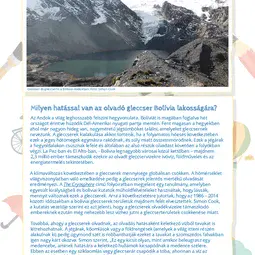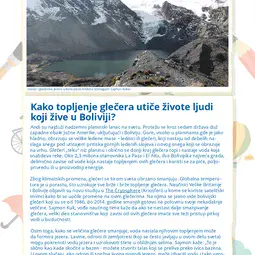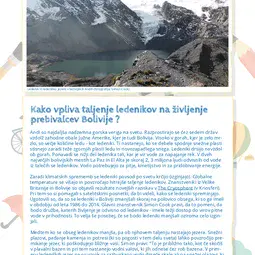How are melting glaciers affecting people in Bolivia?
20 October 2016
The Andes are the longest above-ground mountain range in the world. They stretch through seven countries along the west coast of South America, including Bolivia. Up high in the mountains, where it is very cold, there are large bodies of ice known as glaciers that form when snow falls and gets compressed by the weight of further snowfall on top. Glaciers flow down the mountain-side and, usually, the lower end of the glacier melts to produce water that supplies rivers. In La Paz and El Alto, two of Bolivia’s largest cities, almost 2.3 million people rely in part on this melted water from the glaciers for drinking, farming and energy generation. Due to climate change, glaciers around the world are shrinking. Global temperatures are increasing, which causes the glaciers to melt more and more. Scientists in the UK and Bolivia have published a new study in The Cryosphere that used images from satellites to see how these glaciers are changing. They found that Bolivian glaciers have reduced to almost half their size from 1986 to 2014. Simon Cook, the lead scientist, says, that this means that the communities that rely on the glaciers will find it harder to get access to water in the future, as the glaciers continue to shrink. In addition, as glaciers reduce in size, their melt water can leave behind lakes. Avalanches, rockfalls or earthquakes (which often occur in that part of the world) can burst these lakes causing damage to nearby villages. Simon says: “It’s a bit like when you jump into a swimming pool – you create a wave that splashes over the sides of the pool. Here, it’s a rock or snow avalanche that hits the lake, sending water out and downstream where it can damage villages.” Scientific research like this will help people be prepared for the impact of Bolivia’s melting glaciers. This way, scientists can help protect nearby villages and save lives.Find out more
Discuss with your teacher or parents
Why are global temperatures increasing?
Where are the Andes located in the world and why do glaciers form there?
What are avalanches, rockfalls or earthquakes?
What other things can satellites be used to look at on Earth?
Print version

This is a kids' version of the EGU article: 'How are melting glaciers affecting people in Bolivia?'. It was written by Sarah Connors (EGU Science Policy Fellow, Germany), reviewed for scientific content by Simon Cook (Lecturer at the Manchester Metropolitan University, UK) and Dirk Hoffmann (Coordinator and Senior Researcher, Bolivian Mountain Institute), and for educational content by Teresita Gravina (Don Gnocchi High School, Maddaloni, Italy).
Translations









All English-language Planet Press releases are carefully edited, reviewed and proofed, by scientists, educators and EGU staff. Please note that once translated, Planet Press releases receive no further checks from EGU staff. For this reason, we cannot guarantee their accuracy, though we trust the quality of our voluntary translators and are grateful for their work.

